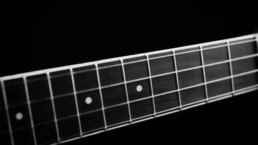Fretboard Woods: Which Type is Best?
If you’re reading this, you probably own a guitar or two. Go pick up your favorite one, and make an observation: what does the fretboard look like? When you play the guitar, how does the fretboard feel? Maybe these are things you’ve never considered before, or have only just begun to wonder about. Not all guitars are created equally. They are ubiquitously made from different combinations of what we call, “tonewoods,” which are woods that resonate well enough to project vibrations made by the strings on your guitar. And when it comes to wood used for fretboards, there are three types that most commonly used.
Ebony, Rosewood, and Maple woods comprise the bulk of materials used to create guitar fretboards. But why these three? Which type is the best? In this article, we’re going to overview these tonewoods and why they are top picks for luthiers!
One very important thing to keep in mind is that there is not one “best” type of wood. There are only types of wood that are best for you and your style of playing or desired aesthetic. In fact, whether or not different woods affect the tone of an electric guitar is a hotly debated topic. A majority of luthiers would agree, however, that the materials they use do impact the resonance, sustain, feel, and tone of a guitar. Let’s take a look at the three primary types of wood used in fretboards. Maybe one of them “resonates” (pun intended) with you!

1. Ebony
Ebony wood has been used for making fretboards since the 1400s, and was considered a superior choice until the last hundred or so years. It is a relatively firm tonewood that is favored for its strength and slick feel. If you are looking for a fretboard that will help you sustain notes better, this is a great pick for you. Ebony fretboard wood also is said to add a sharper, brighter tone to your strings.
Aesthetically, ebony is the darkest wood that you can typically add to your guitar. Brands that are well known for featuring ebony fretboards on their guitars include Gibson, Epiphone, Ibanez, and Jackson. In the picture to the left, you can see how this type of fretboard pairs with a black Gibson Les Paul.

2. Rosewood
Softer than Ebony in both density and appearance, Rosewood has been a top pick amongst luthiers for the last couple hundred years. Because of its porous composition, it is commonly believed that this lends to a softer feeling when fretting notes, as opposed to Ebony’s rigidity. But, this is also the reason that many guitar players will claim that rosewood produces less “bright” of a tone. For fingerstyle guitar players, this might be less desirable, as their plucked notes may not carry enough treble to cut through a mix. For beginner players, though, this might be an ideal fingerboard on which to learn.
As mentioned before, Rosewood is lighter in appearance than Ebony. They are also a very common choice amongst most guitar brands. You would be hard-pressed to find a guitar brand that doesn’t use rosewood on at least a model or two. Some companies are paring back on production of rosewood guitar parts, however, because popular species of Dalbergia (Rosewood) tree are becoming overexploited.
 3. Maple
3. Maple
Maple is the most recent addition to the top three fretboard woods. Its rise in popularity can largely be attributed to Fender. Many of the original Telecasters and Stratocasters feature a “bolt on” neck that is one, solid piece of maple with the frets integrated straight into the neck. To this day, you can still get your hands on a Fender guitar with either a Maple or Rosewood fretboard. Gibson typically does not include Maple fretboards on their guitars. However, the Gibson SG pictured here is part of their limited “Raw Power” series.
Unlike Rosewood, Maple is a harder wood that feels more firm under the fingers. And, similarly to Ebony, it produces a brighter tone and is good for sustaining notes. Unlike Ebony, however, Maple is much hardier. Ebony is known to warp in warmer or humid environments, whereas Maple will hold its shape better. Aesthetically, this type of wood is the lightest in color of these three types of fretboard wood. For some players, these qualities are desirable. For others, these are reasons to avoid Maple fretboards. Remember, it’s all about your personal preference, not about an objective “best” type!
Excited to look at some new guitars? Find all kinds of great guitar gear deals over at Sweetwater.com.
JamPlay has over 450 guitar courses from 120+ instructors, LIVE daily instruction, and online guitar lessons tailored to every skill level, music genre, and playing style. Click here to learn more.
Share this
Become a JamPlay member for unlimited access to 7000+ guitar lessons and 120+ artists and instructors. View membership plans ›



